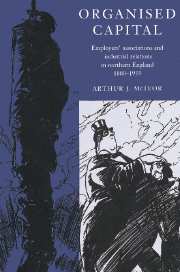Book contents
- Frontmatter
- Contents
- List of maps and tables
- Acknowledgements
- List of abbreviations
- Introduction
- Part 1 Setting the scene
- 1 Context and historiography
- 2 The legacy: origins of employers' associations
- Part 2 Forging employers' organisations, 1880–1920
- Part 3 Reacting to the economic slump, 1920–39
- Conclusion
- Bibliography
- Index
2 - The legacy: origins of employers' associations
Published online by Cambridge University Press: 14 October 2009
- Frontmatter
- Contents
- List of maps and tables
- Acknowledgements
- List of abbreviations
- Introduction
- Part 1 Setting the scene
- 1 Context and historiography
- 2 The legacy: origins of employers' associations
- Part 2 Forging employers' organisations, 1880–1920
- Part 3 Reacting to the economic slump, 1920–39
- Conclusion
- Bibliography
- Index
Summary
Employers' organisations have been around for a very long time, indeed, such organisations pre-dated the industrialisation process in Britain. Adam Smith, in his classic treatise.The Wealth of Nations, was amongst the earliest of commentators to identify the existence of semi-clandestine masters' committees. Such combinations, Smith argued, operated across a number of trades and industries, working to regulate product prices, lower wages and control working hours. The master tailors, for example, formed a number of alliances throughout the second half of the eighteenth century, ostensibly to combat industrial action by their workers, who developed one of the most militant of eighteenth-century unions. Draconian union-bashing and violent strikebreaking tactics were often resorted to by such combinations. In one dispute in 1764, 23 master tailors imported over 1,000 strikebreakers, including 230 from outside Britain. The master tailors' combination dissolved rapidly after breaking this strike. This pattern of brief, temporary, ephemeral combinations of masters to address specific industrial relations crises characterised the eighteenth and early nineteenth centuries. Rarely, during this period, were employers' associations sustained for any length of time. Presumably, in most instances, individual capitalists could effectively discipline and control their labour force without the necessity for forging wider class alliances.
Nevertheless, the extent of employer organisation, even in this early period, should not be underestimated. As the work of Yarmie, Musson, Coleman and Turner has shown, formal employers' combinations dealing with labour relations existed in the cotton, printing, coal, shipbuilding, worsted, cutlery and paper trades during the period of illegality under the multifarious individual trade and general Combination Acts in the late eighteenth century and during the first quarter of the nineteenth century.
- Type
- Chapter
- Information
- Organised CapitalEmployers' Associations and Industrial Relations in Northern England, 1880–1939, pp. 36 - 56Publisher: Cambridge University PressPrint publication year: 1996

